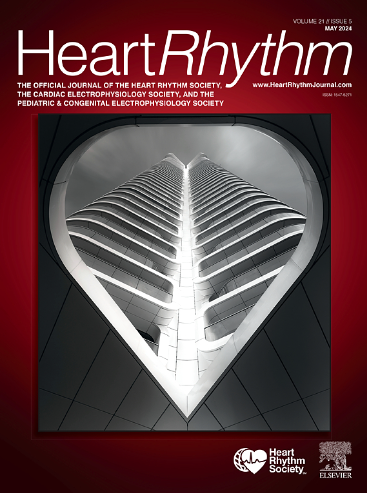新型小直径 OmniaSecure 除颤导线的预测耐用性很高。
IF 5.6
2区 医学
Q1 CARDIAC & CARDIOVASCULAR SYSTEMS
引用次数: 0
摘要
背景:除颤导线仍然是植入式心律转复除颤器的致命弱点。随着植入式心律转复除颤器患者寿命的延长和电池寿命的增加,需要更耐用的导线。LEADR 试验对新型无腔小直径 OmniaSecure 除颤导线进行了评估,结果表明该导线具有良好的安全性和有效性,并且在 12.7 ± 4.8 个月的临床随访中没有发生骨折。为了加强临床试验,我们采用了先进的心脏导联可靠性建模来预测导联的长期耐用性:我们的目的是利用可靠性模型预测 OmniaSecure 除颤导联的 10 年无断裂存活率:方法:经过验证的可靠性模型结合了患者和工作台测试数据,用于预测 OmniaSecure 导联的 10 年无断裂存活率。一部分 LEADR 试验患者在心脏和患者运动过程中接受了双平面透视成像,以评估体内导联的弯曲曲率。然后,在台架试验中再现了这些使用条件,其弯曲曲率比在患者身上观察到的更大,以夸大导线上的应力,并评估导线的疲劳强度:结果:可靠性模型预测 OmniaSecure 导联 10 年无骨折存活率为 98.2%,其中青少年 10 年无骨折存活率为 97.9%,超过了可靠性高、直径更大的 Sprint Quattro 导联的模型和临床 10 年表现:结论:与早期临床试验经验一致,建模预测 OmniaSecure 导联的 10 年性能非常持久,包括在活跃的青少年儿童群体中,他们可能会独特地受益于专为可靠性设计的新型 4.7F 除颤导联:Gov 标识符:NCT04863664。本文章由计算机程序翻译,如有差异,请以英文原文为准。

High predicted durability for the novel small-diameter OmniaSecure defibrillation lead
Background
Defibrillation leads remain the Achilles heel of implantable cardioverter-defibrillators. As patients with implantable cardioverter-defibrillators are living longer and battery longevity increases, more durable leads are needed. The LEADR trial evaluated the novel, lumenless, small-diameter, OmniaSecure defibrillation lead and demonstrated favorable safety and efficacy profile as well as zero fractures through 12.7 ± 4.8 months and remains in clinical follow-up. To augment the clinical trial, advanced cardiac lead reliability modeling was used to project long-term lead durability.
Objective
We aimed to project the 10-year fracture-free survival of the OmniaSecure defibrillation lead using reliability modeling.
Methods
The validated reliability model, which incorporates patient and bench test data, was used to project the 10-year fracture-free survival of the OmniaSecure lead. A subset of LEADR trial patients underwent biplane fluoroscopy imaging during cardiac and patient motion to evaluate the lead’s bending curvature in vivo. Bench tests then reproduced these use conditions with greater bending curvatures than observed in patients to exaggerate stress on the lead and to evaluate the lead fatigue strength.
Results
The reliability modeling projects a 98.2% fracture-free survival rate of the OmniaSecure lead at 10 years, including a 10-year fracture-free survival rate of 97.9% in adolescents, exceeding both the modeled and clinical 10-year performance of the highly reliable, larger diameter Sprint Quattro lead.
Conclusion
Consistent with early clinical trial experience, modeling projects highly durable 10-year performance of the OmniaSecure lead, including within the active adolescent pediatric population, which may uniquely benefit from a novel 4.7F defibrillation lead designed for reliability.
ClinicalTrials.gov identifier
NCT04863664
求助全文
通过发布文献求助,成功后即可免费获取论文全文。
去求助
来源期刊

Heart rhythm
医学-心血管系统
CiteScore
10.50
自引率
5.50%
发文量
1465
审稿时长
24 days
期刊介绍:
HeartRhythm, the official Journal of the Heart Rhythm Society and the Cardiac Electrophysiology Society, is a unique journal for fundamental discovery and clinical applicability.
HeartRhythm integrates the entire cardiac electrophysiology (EP) community from basic and clinical academic researchers, private practitioners, engineers, allied professionals, industry, and trainees, all of whom are vital and interdependent members of our EP community.
The Heart Rhythm Society is the international leader in science, education, and advocacy for cardiac arrhythmia professionals and patients, and the primary information resource on heart rhythm disorders. Its mission is to improve the care of patients by promoting research, education, and optimal health care policies and standards.
 求助内容:
求助内容: 应助结果提醒方式:
应助结果提醒方式:


